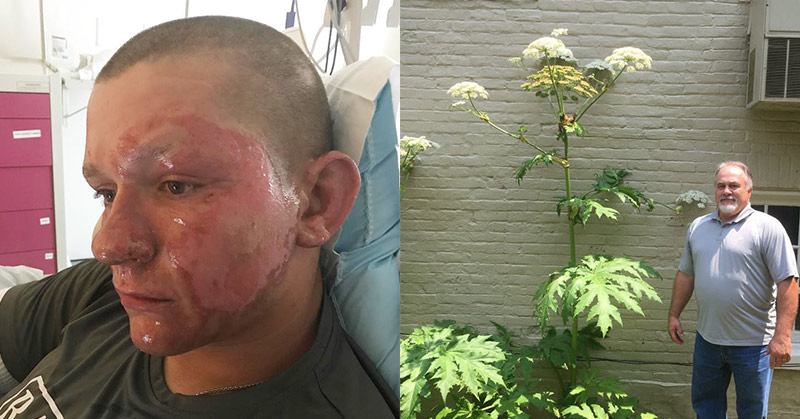Giant hogweed, which can rather appropriately reach impressive heights of over 4.3 meters (14 feet), is a white-topped plant that, at a glance, looks entirely innocuous. Sadly, Heracleum mantegazzianum is actually capable of causing serious injury to anyone that touches it.
The Twitter account of the Massey Herbarium at Virginia Tech University explains that 30 of these monsters have been found in Clarke County, and people have been asked to keep an eye out for any more. No one wants this felonious floral species – which already calls several states home, from Oregon to Illinois – to spread anywhere else.
Dangerous Plant Can Cause Serious Burns
According to the New York State Department of Environmental Conservation, the sap contains photosensitizing furanocoumarins, which act as the plant’s frankly offensive defense mechanism. Get this on you, and it can trigger phytophotodermatitis, a serious inflammation of the skin.
Those pesky chemical compounds in the sap prevent your skin from protecting itself from sunlight. That means that within 15 minutes of getting some on you, your skin can suffer from extremely painful blister-coated burns, with the worst occurring between 30 minutes and 2 hours after initial contact occurs.
The malevolent plant – listed as a “plant pest” in some states and a “Class A noxious weed” in others – spreads itself by dispersing 50,000 seeds or so released in the late summer months, which move via wind or water to somewhere fertile.
17 Year Old Boy Hospitalized After Contact With Hogweed Plant
Editor’s Note: The following segment has been added to the originally published article to provide the most up to date news for our readers!
Alex Childress, 17, of Virgina unfortunately made the news July 12th, after receiving second and even third degree burns from touching a giant hogweed plant. Childress has a summer job doing landscaping and came across a giant hogweed plant at work. Not knowing what it was, he used a pair of loppers to chop it down and throw it aside; during this process, it came into contact with his face and arms.
By the time he got home, Childress’s skin was noticeably red and inflammed. He thought he had gotten a sunburn at first. But his father, Justin Childress, was concerned when he saw him. “The top layer of skin on the left side of his face basically was gone and appeared to be like a really bad burn that had already peeled,” he told Richmond Times Dispatch.
Luckily, Alex’s mother, Christy Childress, is a nurse at VCU Medical Center. When she saw his skin, she suspected the giant hogweed plant, and the family took him to the emergency room for treatment. He spent 2 days in the hospital’s burn unit and received intensive treatment for his condition.
Giant Hogweed: A Dangerous Invasive Species
It’s not just a direct danger to humans, by the way. As noted by the UK-based Centre for Agriculture and Bioscience International (CABI), “it is an undesirable invader on account of its large size, prolific seed production and vigorous growth leading to gross changes in vegetation, obstruction of access to river banks [and] soil erosion.”
This ecological irritant doesn’t just exist in the US either: it can be found all over the world these days, from Iceland to Australia. In the case of Virginia, Massey Herbarium told me that it was planted there intentionally for aesthetic reasons.
When growing anywhere other than the Caucasus Mountains, there isn’t really any other wild plant or animal that can stop its proliferation, and it quickly becomes a tenacious danger wherever it manages to germinate.
In plenty of places, it’s actually illegal to plant it or transport its seeds, and the proper course of action is to have it carefully but completely destroyed. This is made somewhat more difficult by the fact that it has plenty of plant lookalikes.
Although far more dangerous, giant hogweed isn’t the only plant that’s able to make your skin particularly sensitive to sunlight: Carrots, parsnips, and celery contain photosensitizing furanocoumarins too.
There have been medical reports of farmers handpicking such crops while in direct sunlight coming out in extremely painful, and sometimes hospitalizing, blisters and rashes. Indeed, along with giant hogweed, these all belong to the Umbelliferae family of plants. Chefs and bartenders that frequently handle citrus fruits can also get phytophotodermatitis.

If you are unlucky enough to get phytophotodermatitis, you should wash the affected area with soap and cold water as soon as possible. Keep it away from sunlight, and put on plenty of sunscreen. Painkillers and bandages can help, but in some cases, a steroid cream is required.
If it gets into your eyes, rinse quickly with cold water and put on your sunglasses, and hope for the best.





